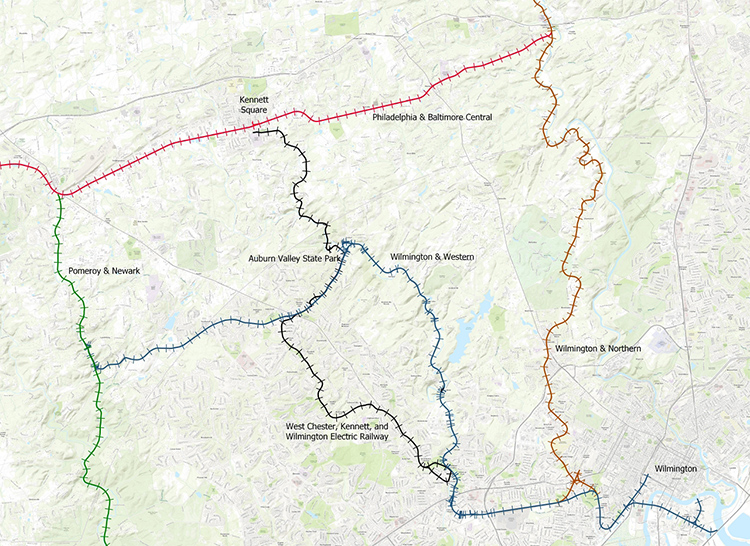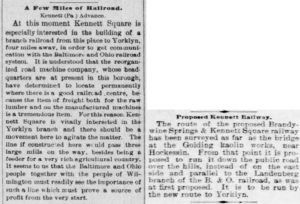INDEFATIGABLE
Both Tom Marshall and this writer have discussed various aspects of the West Chester, Kennett & Wilmington Electric Railway Company, also known as the Kennett Trolley. In 2022 the original deeds for the trolley line that granted right-of-way across the properties of T.S and T.E. Marshall in Chester County, PA as well as the lands of I.W. and T.E Marshall in New Castle County, DE, were uncovered. These deeds provided answers to several questions that existed about the trolley’s route as well as how the trolley would serve the Marshall family and their mills along the Red Clay Creek. The trolley company’s deeds for the trolley’s right-of-way were signed in January 1904 just prior to the trolley beginning service.
Trolley route’s promissory notes, signed in May 1899, were between various Marshall family members and Charles J. Pennock who lead the effort to construct the trolley as the future trolley corporation had not been established as a legal entity. Pennock and others proposed the trolley line earlier than 1899. In what year was connecting Wilmington, DE and Kennett Square, PA by rail first publicly proposed according to newspaper accounts?
Answer
While the need for a direct connection between Wilmington and Kennett Square was likely discussed as part of the planning of the Wilmington & Northern Railroad (brown on the map below) in the mid-1800s, the Wilmington & Northern chose to shadow the Brandywine Creek and include Chadds Ford as a stop. The inclusion of Kennett Square was no doubt heavily proposed as a stop for what eventually became the Pomeroy & Newark Railroad (green on the map) at the start of local railroad history. The Pomeroy & Newark chose to follow the White Clay Creek, and again, Kennett Square lost out to Avondale for rail service. Kennett Square would have to settle for the Philadelphia and Baltimore Central Railroad (red on the map) connecting Avondale and Chadds Ford for their railroad service and a circuitous route of shipments to and from Wilmington.
That did not deter the citizens of Kennett Square from continuing to wish for a direct rail link between Wilmington and Kennett Square. With the planning of the Wilmington & Western Railroad (blue on the map) in the early 1870s, Kennett Square businessmen tried to convince the Wilmington & Western’s board to route their new line along the Red Clay Creek from Kennett to Marshallton and then east to Wilmington. The iron ore and coal freight business proved the more powerful enticement for the Wilmington & Western’s founders and after leaving Wilmington and following the Red Clay north, upon reaching Auburn (now Yorklyn), the new line turned westward towards Landenberg, PA.
In the 1880s, with rapid advancements in electrical technology and the development of the electric railway, Kennett Square businessmen again proposed a connection to Wilmington. Instead of a steam railroad connection they proposed an electric railway be constructed. The first articles proposing and justifying an electric railroad appeared in local newspapers in December 1886. Those living in Kennett Square would end up with a third circuitous route, via Greenbank, DE, to reach Wilmington. The as-built route of the West Chester, Kennett, and Wilmington Electric Railway is shown in black on the map below. Below the map is an article from the Wilmington Morning News from February 16, 1886 – “A Few Miles of Railroad” and another from the News Journal from July 25, 1899 – “Promised Kennett Railway.”


